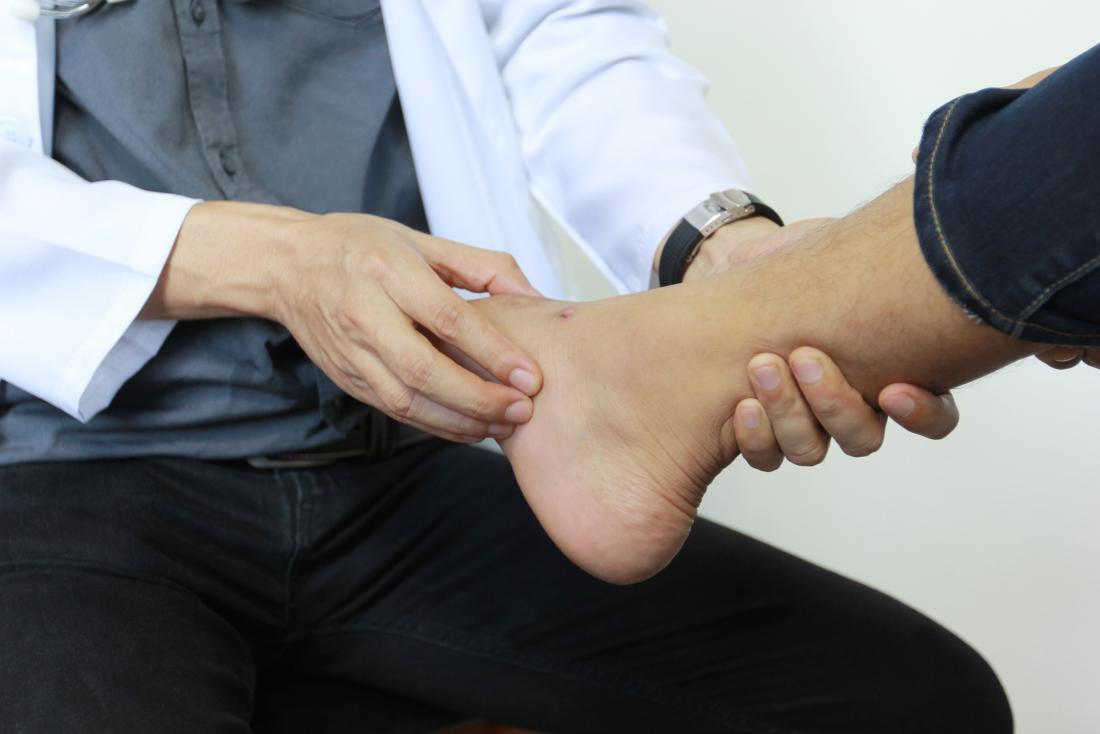Feet are vulnerable to infections, as wearing socks and shoes can create a moist environment for bacteria and fungi to grow in.
However, walking around barefoot can cause a foot injury to become infected.
Proper foot care and treatment can help prevent foot infections from becoming more serious.
Symptoms

A foot infection may make it difficult to walk.
Most types of foot infection cause symptoms. These may include:
- redness and warmth around the affected area
- yellow or green pus
- a foul smell
- swelling
- red or brown discoloration
- pain
- difficulty walking
Pictures
Types
All types of foot infection tend to share similar symptoms, but there are several ways a foot can become infected.
The following are some different types of foot infection, along with tips on how to treat them:
Infected blisters
Blisters are small pockets of fluid that can develop as a result of friction. This can be a result of wearing shoes that are too tight.
Most blisters will heal within a few days without any complications. It is best to avoid picking or bursting a blister, as this can increase the risk of infection. Use a plaster or pad to cover the blister and prevent it from rubbing against any surfaces or footwear.
Treatment
If the blister does become infected, a doctor will typically treat it using antibiotic medications.
Learn more about the signs of and treatments for infected blisters here.
Infections from wounds
Wounds can become infected if bacteria enter the body through tears in the skin. This can cause a skin infection that may range from mild to severe.
Treatment
Covering the wound with a plaster will help protect it from bacteria and other germs. If the wound does become infected, a doctor will typically treat it using antibiotic medications.
Fungal infections
Bacteria can cause many skin infections, but fungi are another possible cause of foot infection.
Fungi thrive in warm, moist environments such as swimming pools, locker rooms, and showers. Regularly visiting these places without proper footwear can lead to a fungal foot infection.
A common type of fungal infection is athlete’s foot. Athlete’s foot, or tinea pedis, often develops between the toes. Fungal infections can also affect the toenails. This causes them to become discolored and take on a thick, crumbly appearance.
Treatment
It is possible to treat most mild cases of athlete’s foot using over-the-counter creams and gels, such as econazole.
For severe fungal infections, a doctor may prescribe stronger antifungal medications.
Cellulitis
Cellulitis occurs when a bacterial infection reaches the deeper layers of the skin.
The American Academy of Dermatology suggest that people with cellulitis receive immediate treatment from a doctor. The infection can quickly become serious and lead to complications such as sepsis.
Treatment
If a person receives antibiotic medications early enough, the infection will usually respond well to the treatment and should reduce.
Ingrown toenail infections
An ingrown toenail occurs when a toenail cuts into the skin surrounding it. Bacteria can enter the through this break in the skin and cause an infection.
Treatment
Ingrown toenails can be painful, and it is important to see a doctor if one becomes infected. In most cases, antibiotic medications can treat the condition without any complications.
Also, the American College of Foot and Ankle Surgeons recommend gently massaging the area or using Epsom salt soaks to help with the pain. They suggest not placing cotton under the nail, as this can also cause infection.
Diabetes and foot infections
People with diabetes are more at risk of developing a foot infection than people without. This is because diabetes damages nerves in the feet, which may prevent people from noticing wounds in this area of the body.
Diabetes can also reduce blood flow to the feet, making it harder for the body to heal wounds and infections there.
An infection in the foot can become serious if a person has diabetes. It may take a long time to heal and can even lead to gangrene. In the most serious cases, this can require amputation.
Treatment
When bacteria are responsible for the infection, a doctor will treat it with antibiotic medications.
It is important to keep the wound clean. Removing any damaged tissue will help prevent the infection from spreading any farther.
Learn more about how diabetes affects the feet here.
Risk factors

A person should see a doctor about certain foot infections, such as cellulitis.
There are several factors that can increase a person’s risk of foot infections, including:
- having a skin condition that causes tears in the skin, such as eczema and psoriasis
- having a weakened immune system, such as from HIV or diabetes
- using swimming pools, public restrooms, or locker rooms without appropriate footwear
- wearing shoes that are the wrong size
- cutting the toenails unevenly
- not keeping the feet clean
- wearing the same shoes too often
- sharing towels, nail clippers, or foot files with other people
- not treating and covering blisters or wounds on the feet
Outlook
Most people who receive treatment for minor foot infections can expect to recover without any complications. However, some types of foot infection, such as cellulitis, require immediate medical attention.
Foot infections can have serious consequences, such as gangrene, for people with diabetes. For this reason, they should take extra care to prevent foot infections.
See a doctor if skin or nail changes occur on the feet. Treating infections early increases the chance of a good outcome.
